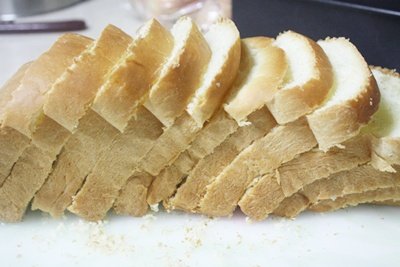Soft & Moist Homemade Sandwich Bread
Making Classic Yeasted Bread: A Comprehensive Guide to Sandwich Loaf

Master the basics of bread making with this detailed recipe for a soft, moist, and delicious sandwich loaf, crafted from a fundamental yeasted dough. Enjoy the warmth and aroma of freshly baked bread right in your own kitchen.
Ingredients- 300g Bread Flour
- 5g Salt
- 40g Sugar
- 9g Instant Dry Yeast
- 180ml Milk
- 1 Egg (lightly beaten)
- 20g Butter (softened at room temperature)
- A little extra flour for dusting
Cooking Instructions
Step 1
First, sift the 300g of bread flour twice for a finer texture. Place the sifted flour into a large mixing bowl and create a well in the center, like a volcano. Around the edges of this well, sprinkle the 9g of instant dry yeast, 5g of salt, and 40g of sugar, ensuring they do not touch each other directly. Salt strengthens gluten for chewiness, while sugar helps the yeast ferment and the bread rise. Keeping them separate prevents the salt from inhibiting the yeast’s activity.

Step 2
With the yeast, salt, and sugar placed around the edges, pour 180ml of milk into the central well of the flour. Using a spatula or your hands, mix everything together until no dry flour remains and the ingredients form a cohesive dough. It might seem shaggy at first, but it will gradually come together.

Step 3
Add the lightly beaten egg to the dough that has just come together with the milk. Beating the egg beforehand ensures it incorporates smoothly into the dough, resulting in a richer flavor, a moister crumb, and a better overall texture for your bread. Continue mixing until the egg is fully incorporated and the dough is smooth.

Step 4
Now begins the intensive kneading process. Work the dough, stretching and folding it repeatedly. Be mindful of your wrists, but knead with energy and purpose. This step is crucial for developing the gluten structure, which gives the bread its characteristic chewy texture and soft crumb.

Step 5
Once the dough starts to develop some elasticity, add the 20g of softened butter. Continue the process of kneading and stretching the dough until the butter is fully incorporated. (Tip: While it’s common to add butter later in the kneading process, adding it slightly earlier like this is also fine, though the dough might feel a bit stickier initially.)

Step 6
As you continue kneading after adding the butter, you’ll notice the dough becoming less sticky and more elastic – you’ll feel that ‘windowpane’ readiness starting to emerge. At this stage, transfer the dough to a clean work surface or a lightly floured countertop. Continue to knead vigorously, as if you were kneading rice cakes, to make the dough smooth and elastic.

Step 7
On your work surface, fold and stretch the dough repeatedly. Then, slam it down firmly onto the surface, folding it over itself. Repeat this process for about 20 minutes until the dough is smooth, elastic, and strong. Thorough kneading develops the gluten, which is key for a well-risen, springy loaf with a delightful texture.

Step 8
Gently stretch a piece of the dough. If it can be stretched thin enough to see light through without tearing, forming a ‘windowpane,’ it’s ready. Shape the dough into a smooth ball and place it in a lightly oiled bowl. Lightly mist the inside of the bowl with water and cover it with a damp cloth. Let it undergo its first fermentation (bulk fermentation) at room temperature for about 40 minutes. (Note: Fermentation times vary by season. In summer, it might take 30-40 minutes; in winter, it could take 50 minutes to an hour.) The dough is ready when it has roughly doubled in size and springs back slowly when poked. Turn the dough out onto your work surface and gently press out the air.

Step 9
Divide the dough into two equal portions. Shape each portion into a ball, cover them with a damp cloth, and let them rest for 15 minutes for intermediate proofing (bench rest). This allows the gluten to relax, making the dough easier to shape later. (During warmer months, you can reduce this to 10-15 minutes.)

Step 10
After the intermediate proof, gently deflate each dough ball again and reshape them into smooth rounds. Then, using a rolling pin, flatten each ball into a rectangle. Fold the two longer sides towards the center, as if you were folding a letter.

Step 11
Now, roll the folded dough up tightly but gently. Avoid pressing too hard, aiming for an even roll. Lightly dust your work surface with extra bread flour as you roll to prevent sticking.

Step 12
Grease your sandwich loaf pan thoroughly with butter. Place the shaped dough rolls into the pan, spacing them slightly apart. This gives them room to expand during the second proof and baking.

Step 13
Cover the loaf pan with a damp cloth and let it proof for a second time (final proof) at room temperature for 35-40 minutes. On hot days, the dough might double in size in as little as 30 minutes. The dough is ready when it has risen to about 80-90% of the height of the pan.

Step 14
You’ll see that the dough has puffed up beautifully, nearly filling the pan. About 20 minutes into the second proof, preheat your oven to 180°C (350°F). Bake the loaf in the preheated oven for approximately 30 minutes, or until golden brown and cooked through. (Oven temperatures and baking times may vary.)

Step 15
Once baked, carefully remove the bread from the pan and place it on a wire rack to cool completely. Allowing the bread to cool fully before slicing will ensure clean cuts and prevent it from collapsing. Enjoy your delicious, homemade sandwich bread!




